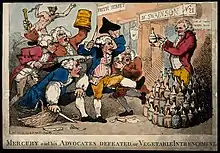Isaac Swainson
Isaac Swainson (1746–1812) was famous for his botanical garden, which was largely funded from the profits of a herbal remedy for venereal disease. For his commercial activities in the latter field, he has been called a "radical quack".[1] He was a relative of William John Swainson, the naturalist. A plant genus is named after him. A biography has been recently produced [2]

Velno's Vegetable Syrup
Swainson moved to London where he served as assistant to a Dr. Mercier in Frith Street, Soho, where he settled. Later, he purchased from Dr Mercier the recipe of a patent medicine called "Velnos’ Vegetable Syrup", named after Vergery de Velnos. This was one of many cures for venereal diseases based on vegetables rather than mercury, which is extremely toxic. This brand became well-known and Swainson reputedly made as much as £5,000 a year from its sales.[3] In addition to curing various venereal diseases, including “the pox” and the “French disease”, it was claimed to cure leprosy, gout, scrophula, dropsy, small pox, consumption, tape worms, cancer, scurvy, and diarrhea [4]
Whether he believed in the efficacy of his remedy or not, he did study the conventional medicine of the era and gained an MD in 1785, although there is no record of his subsequent election to the Royal College of Physicians.[3]
Sturt's Desert Pea
Swainson, who was less noted for botany, is honoured by the genus name Swainsona, which is now known as the emblem of South Australia. Its common name is Sturt's desert pea.[5]
Publications
References
- McCalman, Iain. "Newgate in Revolution: Radical Enthusiasm and Romantic Counterculture." Eighteenth-Century Life 22, (1998) 95-110
- "Geri Walton Unique histories from the 18th and 19th centuries. "Velnos' Vegetable Syrup Sold by Isaac Swainson"".
- "Twickenham Museum Biography".
- . Birth Control in Nineteenth-Century England, by Angus Mclaren; 1978. Holmes & Meier
- http://www.anbg.gov.au/emblems/sa.emblem.html Australian National Botanic Gardens